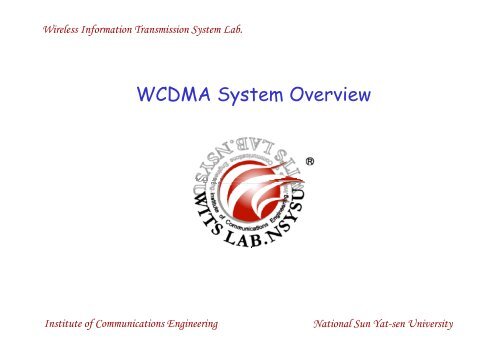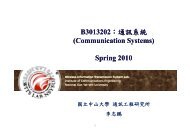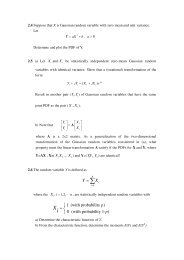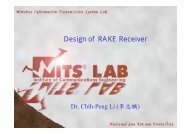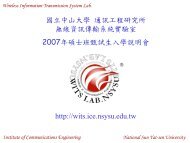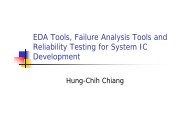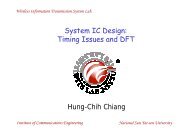You also want an ePaper? Increase the reach of your titles
YUMPU automatically turns print PDFs into web optimized ePapers that Google loves.
Wireless Information Transmission <strong>System</strong> Lab.<br />
Institute of Communications Engineering<br />
<strong>WCDMA</strong> <strong>System</strong> <strong>Overview</strong><br />
National Sun Yat-sen University
Background and Standardization of <strong>WCDMA</strong><br />
<strong>WCDMA</strong> <strong>System</strong> Architecture<br />
UTRAN (UMTS Terrestrial Radio Access Network)<br />
Architecture<br />
3GPP TS 25.401<br />
Table of Contents<br />
2
Wireless Information Transmission <strong>System</strong> Lab.<br />
Background and Standardization<br />
of <strong>WCDMA</strong><br />
Institute of Communications Engineering<br />
National Sun Yat-sen University
Air Interfaces for 3rd Generation<br />
<strong>System</strong>s<br />
Since 1985, ITU (International Telecommunications Union) has<br />
been developing IMT-2000, previously termed Future Public Land<br />
Mobile Telephone <strong>System</strong> (FPLMTS).<br />
In 1992, the World Administrative Radio Conference (WARC) of<br />
the ITU identified the frequencies around 2 GHz for future 3rd<br />
generation mobile systems, both terrestrial and satellite.<br />
Within the ITU, the 3rd generation systems are called<br />
International Mobile Telephony 2000 (IMT-2000). In Europe, it<br />
is called UMTS (Universal Mobile Telephone Service).<br />
Original target: a single common global IMT-2000 air interface.<br />
Specification has been created in 3GPP (the 3rd Generation<br />
Partnership Project), which is the joint standardisation project of<br />
the standardisation bodies from Europe, Japan, Korea, the USA<br />
and China.<br />
4
Air Interfaces for 3rd Generation<br />
<strong>System</strong>s<br />
Within 3GPP, <strong>WCDMA</strong> is called UTRA (Universal Terrestrial<br />
Radio Access) FDD and TDD.<br />
In addition to <strong>WCDMA</strong>, the other air interfaces that can be used<br />
to provide third generation services are EDGE and cdma2000.<br />
EDGE (Enhanced Data Rates for GSM Evolution) can provide<br />
third generation services with bit rates up to 500 kbps within a<br />
GSM carrier spacing of 200 kHz.<br />
EDGE includes advanced features that are not part of GSM to<br />
improve spectrum efficiency and to support the new services.<br />
cdma2000 can be used as an upgrade solution for the existing IS-<br />
95 operators.<br />
5
Air Interfaces for 3rd Generation<br />
<strong>System</strong>s<br />
In Europe and in most of Asia, IMT-2000 (or WARC-92)<br />
band uses 1920-1980 MHz (uplink) and 2110-2170 MHz<br />
(downlink) for <strong>WCDMA</strong> FDD mode and 1900-1920 MHz and<br />
2020-2025 MHz for <strong>WCDMA</strong> TDD mode.<br />
FDD systems use different frequency bands for uplink and<br />
downlink.<br />
TDD systems use same frequency for both uplink and<br />
downlink.<br />
In China, depending on the regulation decisions, up to 2 x 60<br />
MHz of the IMT-2000 spectrum will be available for<br />
<strong>WCDMA</strong> FDD and the TDD spectrum will also be available.<br />
In the USA, no new spectrum has yet been made available for<br />
3rd generation systems.<br />
6
2 GHz Band Spectrum Allocation<br />
7
Europe<br />
RACE I (Research of Advanced Communication Technologies<br />
in Europe) program started the basic 3rd generation research<br />
work in 1988.<br />
RACE II program develops the CDMA-based CODIT (Code<br />
Division Testbed) and TDMA-based ATDMA (Advanced<br />
TDMA Mobile Access) air interfaces during 1992-95.<br />
European research program ACTS (Advanced Communication<br />
Technologies and Services) was launched at the end of 1995 to<br />
support mobile communications research and development.<br />
Within ACTS, the FRAMES (Future Radio Wideband Multiple<br />
Access <strong>System</strong>) project was set up to define a proposal for a<br />
UMTS radio access system.<br />
Nokia, Siemens, Ericsson, France Telecom, CSEM/Pro Telecom.<br />
8
Europe<br />
FRAMES wideband CDMA and wideband TDMA proposals<br />
were submitted to ETSI (European Telecommunications<br />
Standards Institute) as candidates for UMTS air interface and<br />
ITU IMT-2000 submission.<br />
After submission and presentation during 1996 and early 1997,<br />
proposals for the UMTS Terrestrial Radio Access (UTRA) air<br />
interface were grouped into five concept groups in ETSI in<br />
June 1997.<br />
Wideband CDMA (<strong>WCDMA</strong>)<br />
Wideband TDMA (WTDMA)<br />
TDMA/CDMA<br />
OFDMA<br />
ODMA<br />
9
Europe<br />
In January 1998, ETSI selects <strong>WCDMA</strong> as the standard for the<br />
UTRA (UMTS Terrestrial Radio Access) air interface on the<br />
paired frequency bands, i.e. for FDD (Frequency Division<br />
Duplexing) operation, and WTDMA/CDMA for operation with<br />
unpaired spectrum allocation, i.e. for TDD (Time Division<br />
Duplexing) operation.<br />
The detailed standardization of UTRA proceeded within ETSI<br />
until the work was handed over to the 3rd Generation<br />
Partnership Project (3GPP).<br />
The technical work was transferred to 3GPP with the<br />
contribution of UTRA in early 1999.<br />
10
Japan<br />
ARIB (the Association for Radio Industries and<br />
Businesses) was established in April 1993 to evaluate<br />
possible 3rd generation systems around three different<br />
main technologies based on <strong>WCDMA</strong>, WTDMA and<br />
OFDMA.<br />
The <strong>WCDMA</strong> technology in Japan was very similar to<br />
that being considered in Europe in ETSI.<br />
ARIB selected <strong>WCDMA</strong>, with both FDD and TDD<br />
modes operation, in 1997.<br />
<strong>WCDMA</strong> was chosen in ARIB before the process was<br />
completed in ETSI.<br />
ARIB contributed their <strong>WCDMA</strong> to 3GPP.<br />
11
The United States<br />
Main standardization activities for wireless systems are carried out in<br />
TIA Engineering Committee TR45 and TR46, and in the T1<br />
committee T1P1.<br />
TR45.5 is responsible for the IS-95, TR45.3 for the IS-136, and T1P1<br />
with TR46 are jointly for GSM1900.<br />
Industry forums: UWCC for IS-136, CDMA Development Group<br />
(CDG) for IS-95, and the GSM Alliance and GSM North America for<br />
GSM.<br />
In April 1997, CDG issued the Advanced <strong>System</strong>s initiative to develop<br />
the IS-95 based 3rd generation air interface proposal.<br />
In 1997, proposals from Hughes, Lucent, Motorola, Nokia, Nortel,<br />
Qualcomm, and Samsung, were submitted to TR45.5 for cdma2000,<br />
all backward compatible to IS-95.<br />
In March 1998, TR45.5 agreed on the basic framework for cdma2000:<br />
cdma2000 1x has same bandwidth as IS-95 (1.25 MHz) and cdma2000<br />
3x, also called multicarrier CDMA, three times the bandwidth of IS-95.<br />
12
Korea<br />
TTA (Telecommunications Technology Association) adopted a<br />
two-track approach to the development of 3rd CDMA<br />
technology.<br />
ETRI established an R&D consortium to define the Korean<br />
proposal for IMT-2000 in 1997 and 1999.<br />
A wideband CDMA proposal has been developed within ETRI,<br />
which forms the basis for the TTA I scheme.<br />
SK Telecom (previously KMT, Korea Mobile Telecom) merged<br />
with other industrial proposals at the beginning of 1998 and<br />
formed the TTA II scheme.<br />
The TTA1 and TTA2 air interface proposals (later renamed<br />
Global CDMA 1 and 2) were based on synchronous and<br />
asynchronous wideband CDMA technologies respectively.<br />
Korean standardization efforts were later moved to 3GPP and<br />
3GPP2 to contribute to <strong>WCDMA</strong> and cdma2000.<br />
13
14<br />
3GPP<br />
3GPP (3rd Generation Partnership Project) was founded in<br />
1998.<br />
The standardization organizations involved were ARIB (Japan),<br />
ETSI (Europe), TTA (Korea), TTC (Japan) and T1P1 (USA).<br />
The partners agreed on joint efforts for the standardization of<br />
UTRA, now standing for Universal Terrestrial Radio Access.<br />
In 1999, CWTS (the China Wireless Telecommunication<br />
Standard Group) joined 3GPP and contributed technology from<br />
TD-SCDMA, a TDD-based CDMA 3rd generation technology<br />
already submitted to ITU-R earlier.
15<br />
3GPP<br />
The first version of the common specification, called<br />
Release-99, was ready by the end of 1999.<br />
Within 3GPP, four different technical specification<br />
groups (TSG) were set up:<br />
Radio Access Network (RAN) TSG<br />
Core Network TSG<br />
Service and <strong>System</strong> Aspects TSG<br />
Terminals TSG
3GPP RAN TSG<br />
Within the TSGs, the one most relevant to the <strong>WCDMA</strong><br />
technology is the RAN TSG.<br />
Radio Access Network Technical Specification Group<br />
WG 1<br />
Radio<br />
Layer 1<br />
WG 2<br />
Radio<br />
Layer 2/3<br />
WG 3 WG 4<br />
Architecture<br />
& Interface<br />
16<br />
Radio<br />
Performance<br />
& RF<br />
Parameters<br />
ITU Ad Hoc<br />
ITU Activity<br />
Co-ordination
3GPP2<br />
Work done in TR45.5 and TTA was merged to form<br />
3GPP2.<br />
Focused on cdma2000 Direct-Sequence (DS) and Multi-<br />
Carrier (MC) mode.<br />
This activity has been running in parallel with the 3GPP<br />
project, with participation from ARIB, TTC, and CWTS<br />
as member organizations.<br />
DS mode was abandoned.<br />
17
Harmonization Phase<br />
Manufacturers and operators agreed to adopt a<br />
harmonized global 3rd generation CDMA standard<br />
consisting of three modes: Multi-Carrier (MC) mode<br />
based on the cdma2000 multi-carrier option, Direct<br />
Spread (DS) mode on <strong>WCDMA</strong> (UTRA FDD), and the<br />
Time Division Duplex (TDD) mode on UTRA TDD.<br />
UTRA FDD and TDD mode chip rate were changed<br />
from 4.096 Mcps to 3.84 Mcps.<br />
18
Parameters of <strong>WCDMA</strong><br />
Channel Bandwidth: 5 MHz<br />
Duplex Mode: FDD and TDD<br />
Spread Spectrum Technique: Direct Spread<br />
Chip Rate: 3.84 MHz<br />
Frame Length: 10 ms (38400 chips/sce)<br />
Slot Length: 15 Slots per Frame (2560 chips/slot)<br />
Spreading Modulation: Balanced QPSK (downlink)<br />
and Dual-Channel QPSK (uplink) with complex<br />
spreading circuit.<br />
Data Modulation: QPSK (downlink) and BPSK<br />
(uplink).<br />
19
Parameters of <strong>WCDMA</strong><br />
Channel Coding: Convolutional code, Turbo code, and no coding.<br />
Spreading Factors: 4-256 (uplink) and 4-512 (downlink).<br />
Modulation symbol rates vary from 960 k symbols/s to 15 k<br />
symbols/s (7.5 k symbols/s) for FDD uplink (downlink).<br />
Spreading (downlink): OVSF sequences for channel separation.<br />
Gold sequences 218-1 for cell and user separation (truncated<br />
cycle: 10 ms).<br />
Spreading (uplink): OVSF sequences for channel separation.<br />
Gold sequences 225-1 for user separation (truncated cycle: 10<br />
ms).<br />
20
Carrier spacing<br />
Frequency reuse factor<br />
Power control frequency<br />
Quality control<br />
Frequency diversity<br />
Packet data<br />
DL transmit diversity<br />
<strong>WCDMA</strong> vs. GSM<br />
<strong>WCDMA</strong><br />
5 MHz<br />
1<br />
1.5 kHz<br />
Radio resource<br />
management algorithm<br />
Multipath diversity with<br />
RAKE receiver<br />
Load-based packet<br />
scheduling<br />
Supported for improving<br />
downlink capacity.<br />
21<br />
GSM<br />
200 kHz<br />
1-18<br />
2 Hz or lower<br />
Network planning<br />
(frequency planning)<br />
Frequency hopping.<br />
Time slot based scheduling<br />
with GPRS<br />
Not supported by standard but<br />
can be applied
Carrier spacing<br />
Chip rate<br />
Power control<br />
Base station<br />
synchronization<br />
Inter-frequency handover<br />
Radio resource<br />
management<br />
Packet data<br />
DL transmit diversity<br />
<strong>WCDMA</strong> vs. IS-95<br />
<strong>WCDMA</strong><br />
5 MHz<br />
3.84 Mcps<br />
1.5 kHz for both uplink and<br />
downlink.<br />
Not needed<br />
Yes<br />
Yes, provides required<br />
quality of service.<br />
Load-based packet<br />
scheduling<br />
Supported<br />
22<br />
IS-95<br />
1.25 MHz<br />
1.2288 Mcps<br />
UL: 800Hz<br />
DL: slow control<br />
Needed (typically GPS)<br />
Possible but not specified<br />
Not needed for speech only<br />
network<br />
Transmitted as short<br />
circuit-switched calls<br />
Not supported
Core Network Relation to the 3rd<br />
Generation Air Interface Alternatives<br />
23
Wireless Information Transmission <strong>System</strong> Lab.<br />
<strong>WCDMA</strong> <strong>System</strong> Architecture<br />
Institute of Communications Engineering<br />
National Sun Yat-sen University
Basic Architecture of GSM<br />
25
GSM Network Architecture<br />
26
Channel Codec Unit<br />
(CCU)<br />
• Channel Coding<br />
• Radio Channel<br />
Measurements<br />
GPRS Architecture<br />
BSS<br />
PCU<br />
Packet Control Unit (PCU)<br />
• channel access control<br />
• radio channel management<br />
• data packet segmentation<br />
and re-assembly<br />
Visited<br />
MSC /VLR<br />
27<br />
HLR<br />
Gateway<br />
MSC /VLR<br />
SGSN GGSN<br />
HLR Extension<br />
• GPRS subscriber data<br />
• routing information<br />
PSTN<br />
External<br />
Data<br />
Network<br />
Serving GPRS Support Node (SGSN)<br />
• functions comparable to VMSC/VLR<br />
Gateway GPRS Support Node (GGSN)<br />
• functions comparable to GMSC
SGSN<br />
A<br />
Um<br />
MS BSS<br />
GPRS Interfaces<br />
D<br />
MSC /VLR HLR<br />
Gb<br />
E<br />
Gs<br />
SMS-GMSC<br />
SMS-IWMSC<br />
Gd<br />
SGSN<br />
Gn Gp<br />
GGSN<br />
other PLMN<br />
28<br />
Gn<br />
C<br />
Gr<br />
Gf<br />
GGSN<br />
EIR<br />
Gc<br />
Gi<br />
Signaling &<br />
Data Transfer<br />
Signaling<br />
PDN TE
IP/<br />
X.25<br />
L2‘<br />
L1‘<br />
Relay<br />
IP/<br />
X.25<br />
SND<br />
CP<br />
LLC<br />
RLC<br />
MAC<br />
GSM<br />
RF<br />
GPRS Transmission Planes<br />
Um<br />
MS BSS<br />
Gb Gn<br />
SGSN GGSN Gi<br />
RLC<br />
MAC<br />
GSM<br />
RF<br />
Relay<br />
Application/ Higher level protocols<br />
BSS<br />
GP<br />
FR<br />
L1 bis<br />
SND<br />
CP<br />
LLC<br />
BSS<br />
GP<br />
FR<br />
L1 bis<br />
29<br />
Relay<br />
GTP GTP<br />
UDP /<br />
TCP<br />
IP IP<br />
L2 L2<br />
L1<br />
Relay<br />
IP/<br />
X.25<br />
UDP /<br />
TCP<br />
BSSGP : BSS GPRS Protocol LLC : Logical Link Control SNDCP : SubNetwork Dependent<br />
FR : Frame Relayl MAC : Medium Access Control Convergence Protocol<br />
GTP : GPRS Tunnelling Protocol RLC : Radio Link Control TCP : Transmission Control Protocol<br />
IP : Internet Protocol UDP : User Datagram Protocol<br />
L1<br />
IP/<br />
X.25<br />
L2‘<br />
L1‘<br />
Router<br />
IP/<br />
X.25<br />
L2‘<br />
L1‘
GPRSspecific<br />
MAP<br />
extension<br />
SGSN<br />
GGSN<br />
MAP<br />
Mobile<br />
Application<br />
Part<br />
TCAP<br />
Transaction<br />
Capabilities<br />
Application Part<br />
SCCP<br />
Signaling Conne -<br />
ction Control Part<br />
MTP L3<br />
MTP L2<br />
L1<br />
GPRS Signaling Planes<br />
Gr ,f,d<br />
Gc<br />
HLR, EIR,<br />
SMS-GMSC<br />
HLR<br />
MAP<br />
Mobile<br />
Application<br />
Part<br />
TCAP<br />
SCCP<br />
MTP L3<br />
MTP L2<br />
L1<br />
30<br />
SGSN Gs MSC /VLR<br />
BSSAP+<br />
SCCP<br />
MTP L3<br />
MTP L2<br />
L1<br />
BSSAP+<br />
BSS<br />
Application<br />
Part +<br />
SCCP<br />
MTP L3<br />
MTP L2<br />
L1<br />
Subset of<br />
BSSAP<br />
functionalities
UMTS Network Architecture<br />
31
USIM<br />
ME<br />
Cu<br />
UE<br />
Network Elements in a <strong>WCDMA</strong> PLMN<br />
Uu Iu<br />
Node B<br />
Node B<br />
Node B<br />
Node B<br />
RNC<br />
Iub Iur<br />
UTRAN<br />
RNC<br />
32<br />
MSC/VLR GMSC<br />
HLR<br />
SGSN GGSN<br />
Core Network<br />
•PLMN: Public Land Mobile Network.<br />
•One PLMN is operated by a single operator.<br />
PLMN, PSTN<br />
ISDN, … etc.<br />
Internet<br />
External<br />
Networks
The UE consists of two parts:<br />
User Equipment (UE)<br />
The Mobile Equipment (ME) is the radio terminal<br />
used for radio communication over the Uu interface.<br />
The UMTS Subscriber Identity Module (USIM) is a<br />
smartcard that holds the subscriber identity, performs<br />
authentication algorithms, and stores authentication<br />
and encryption keys and some subscription<br />
information that is needed at the terminal.<br />
33
UMTS Terrestrial Radio Access Network --<br />
UTRAN<br />
UTRAN consists of two distinct elements:<br />
The Node B converts the data flow between the<br />
Iub and Uu interfaces. It also participates in radio<br />
resource management.<br />
The Radio Network Controller (RNC) owns and<br />
controls the radio resources in its domain (the<br />
Node Bs connected to it). RNC is the service<br />
access point for all services UTRAN provides the<br />
core network (CN).<br />
34
<strong>WCDMA</strong> <strong>System</strong> Architecture<br />
UMTS system utilizes the same well-known<br />
architecture that has been used by all main 2nd<br />
generation systems.<br />
The network elements are grouped into:<br />
The Radio Access Network (RAN, UMTS Terrestrial RAN =<br />
UTRAN) that handles all radio-related functionality.<br />
The Core Network (CN) which is responsible for switching<br />
and routing calls and data connections to external networks.<br />
Both User Equipment (UE) and UTRAN consist of<br />
completely new protocols, which is based on the new<br />
<strong>WCDMA</strong> radio technology.<br />
The definition of CN is adopted from GSM.<br />
35
Main Elements of the GSM Core Network<br />
HLR (Home Location Register) is a database located in<br />
the user’s home system that stores the master copy of<br />
the user’s service profile.<br />
The service profile consists of, for example, information on<br />
allowed services, forbidden roaming areas, and Supplementary<br />
Service information such as status of call forwarding and the<br />
call forwarding number.<br />
It is created when a new user subscribes to the system.<br />
HLR stores the UE location on the level of MSC/VLR and/or<br />
SGSN.<br />
36
Main Elements of the GSM Core Network<br />
MSC/VLR (Mobile Services Switching Center / Visitor<br />
Location Register) is the switch (MSC) and database<br />
(VLR) that serves the UE in its current location for<br />
circuit switched services.<br />
The MSC function is used to switch the CS transactions.<br />
The VLR function holds a copy of the visiting user’s service<br />
profile, as well as more precise information on the UE’s<br />
location within the serving system.<br />
37
Main Elements of the GSM Core Network<br />
GMSC (Gateway MSC) is the switch at the point where<br />
UMTS PLMN is connected to external CS networks.<br />
All incoming and outgoing circuit switched connections go<br />
through GMSC.<br />
SGSN (Serving GPRS (General Packet Radio Service)<br />
Support Node) functionality is similar to that of<br />
MSC/VLR, but is typically used for Packet Switched<br />
(PS) services.<br />
GGSN (Gateway GPRS Support Node) functionality is<br />
close to that of GMSC but is in relation to PS services.<br />
38
Interfaces<br />
Cu Interface: this is the electrical interface between the USIM<br />
smartcard and the ME. The interface follows a standard format<br />
for smartcards.<br />
Uu Interface: this is the <strong>WCDMA</strong> radio interface, which is the<br />
subject of the main part of <strong>WCDMA</strong> technology. This is also<br />
the most important open interface in UMTS.<br />
Iu Interface: this connects UTRAN to the CN.<br />
Iur Interface: the open Iur interface allows soft handover<br />
between RNCs from different manufacturers.<br />
Iub Interface: the Iub connects a Node B and an RNC. UMTS<br />
is the first commercial mobile telephony system where the<br />
Controller-Base Station interface is standardized as a fully<br />
open interface.<br />
39
Wireless Information Transmission <strong>System</strong> Lab.<br />
UTRAN Overall Description<br />
Institute of Communications Engineering<br />
National Sun Yat-sen University
General Protocols Architecture<br />
The protocols over Uu and Iu interfaces are divided<br />
into two structures:<br />
User plane protocols<br />
These are the protocols implementing the actual radio<br />
access bearer service, i.e. carrying user data through the<br />
access stratum.<br />
Control plane protocols<br />
These are the protocols for controlling the radio access<br />
bearers and the connection between the UE and the<br />
network from different aspects (including requesting the<br />
service, controlling different transmission resources,<br />
handover & streamlining etc.).<br />
41
User Plane<br />
The radio access bearer service is offered from<br />
service access point (SAP) to SAP by the Access<br />
Stratum. The following figure shows the protocols<br />
on the Uu and Iu interfaces that link together to<br />
provide this radio access bearer service.<br />
Radio<br />
protocols<br />
(1)<br />
Non-Access Stratum<br />
Radio<br />
protocols<br />
(1)<br />
UE<br />
Radio<br />
(Uu)<br />
Access Stratum<br />
UTRAN Iu<br />
CN<br />
42<br />
Iu<br />
proto<br />
cols<br />
(2)<br />
Iu<br />
proto<br />
cols<br />
(2)
Control Plane<br />
The following figure shows the control plane (signalling)<br />
protocol stacks on Iu and Uu interfaces.<br />
Non-Access Stratum<br />
CM,MM,GMM,SM CM,MM,GMM,SM<br />
Radio<br />
protocols<br />
(1)<br />
Radio<br />
protocols<br />
(1)<br />
UE<br />
Radio<br />
(Uu)<br />
Access Stratum<br />
UTRAN Iu<br />
CN<br />
43<br />
Iu<br />
proto<br />
cols<br />
(2)<br />
Iu<br />
proto<br />
cols<br />
(2)
UTRAN<br />
RNS<br />
RNC<br />
UTRAN Architecture<br />
Core Network<br />
Iu Iu<br />
Iur<br />
44<br />
RNS<br />
Iub Iub<br />
Iub<br />
RNC<br />
Node B Node B Node B Node B<br />
Iub
UTRAN Architecture<br />
UTRAN consists of one or more Radio Network Subsystems<br />
(RNS), which are connected to the core network<br />
through the Iu.<br />
An RNS is a sub-network within UTRAN and consists<br />
of one Radio Network Controller (RNC) and one or<br />
more Node Bs.<br />
A Node B can support FDD mode, TDD mode, or dualmode<br />
operation.<br />
RNCs may be connected to each other via Iur interface.<br />
45
UTRAN Architecture<br />
RNCs and Node Bs are connected with an Iub<br />
interface.<br />
The RNC is responsible for the Handover decisions<br />
that require signaling to the UE.<br />
A RNC may include a combining/splitting function to<br />
support combination/splitting of information streams.<br />
Inside the UTRAN, the RNCs of the Radio Network<br />
Subsystems can be interconnected together through<br />
the Iur.<br />
46
Main Characteristics of UTRAN<br />
Support of UTRA and all the related functionalities.<br />
UTRAN has to support soft handover and the<br />
<strong>WCDMA</strong>-specific Radio Resource Management<br />
algorithms.<br />
UTRA stands for UMTS Terrestrial Radio Access in ETSI<br />
and Universal Terrestrial Radio Access in 3GPP.<br />
Maximization of the commonalities in the handling<br />
of packet-switched and circuit-switched data, with a<br />
unique air interface protocol stack.<br />
Use of the ATM transport as the main transport<br />
mechanism in UTRAN.<br />
47
Radio Network Controller (RNC)<br />
RNC is responsible for the control of the radio<br />
resources of UTRAN.<br />
RNC interfaces with the core network (normally to<br />
one MSC and one SGSN).<br />
RNC terminates the RRC (Radio Resource Control)<br />
protocol that defines the messages and procedures<br />
between the mobile and UTRAN.<br />
RNC logically corresponds to the GSM BSC.<br />
48
Logical Role of the RNC<br />
Controlling RNC (CRNC): the RNC controlling a<br />
given Node B (i.e. terminating the Iub interface<br />
towards the Node B).<br />
CRNC is responsible for the load and congestion<br />
control of its own cells.<br />
CRNC executes the admission control and code<br />
allocation for new radio links to be established in<br />
those cells.<br />
49
UE<br />
Logical Role of the RNC<br />
In case one mobile-UTRAN connection uses<br />
resources from more than one RNS, the RNC<br />
involved have two separate logical roles (with respect<br />
to this mobile-UTRAN connection):<br />
Serving RNC (SRNC).<br />
Drift RNC (DRNC).<br />
Node B<br />
Node B<br />
Node B<br />
Node B<br />
SRNC<br />
Iub Iur<br />
UTRAN<br />
DRNC<br />
RNS<br />
RNS<br />
Iu<br />
50<br />
UE<br />
Node B<br />
Node B<br />
Node B<br />
Node B<br />
SRNC<br />
Iub Iur<br />
UTRAN<br />
DRNC<br />
RNS<br />
RNS<br />
Iu
Serving RNC (SRNC)<br />
One UE connected to UTRAN has one and only one<br />
SRNC.<br />
The SRNC for one mobile is the RNC that terminates both<br />
the Iu link for the transport of user data and the<br />
corresponding RANAP (RAN application part) signaling<br />
to/from the core network.<br />
SRNC also terminates the Radio Resource Control<br />
Signaling, that is the signaling protocol between the UE<br />
and UTRAN.<br />
SRNC executes basic Radio Resource Management<br />
operations, such as handover decision, outer loop power<br />
control, and the mapping of Radio Access Bearer<br />
parameters into air interface transport channel parameters.<br />
SRNC performs L2 processing of the data to/from the<br />
radio interface.<br />
51
Drift RNC (DRNC)<br />
One UE may have zero, one or more DRNCs.<br />
DRNC is any RNC, other than the SRNC, that<br />
controls cells used by the mobile.<br />
DRNC may perform macro-diversity combining.<br />
DRNC does not perform L2 processing of the user<br />
plane data.<br />
DRNC routes the data transparently between the Iub<br />
and Iur interface, except when the UE is using a<br />
common or shared transport channel.<br />
52
Transfer of User Data<br />
UTRAN Functions List<br />
Radio channel ciphering and deciphering<br />
Integrity protection.<br />
Synchronization.<br />
Functions related to broadcast and multicast services.<br />
Overall system access control:<br />
Admission Control.<br />
Congestion Control.<br />
<strong>System</strong> information broadcasting.<br />
53
Functions related to mobility:<br />
Handover;<br />
SRNS Relocation;<br />
Paging support;<br />
Positioning.<br />
UTRAN Functions List<br />
Functions related to radio resource management and<br />
control:<br />
Radio resource configuration and operation.<br />
Radio environment survey;<br />
Combining/splitting control.<br />
Connection set-up and release;<br />
54
UTRAN Functions List<br />
Functions related to radio resource management and<br />
control (continue):<br />
Allocation and deallocation of Radio Bearers;<br />
Radio protocols function;<br />
RF power control.<br />
Radio channel coding;<br />
Channel coding control;<br />
Initial (random) access detection and handling.<br />
CN Distribution function for Non Access Stratum messages.<br />
55
DRNS<br />
Core Network<br />
Iur<br />
UE<br />
Serving RNS Relocation<br />
SRNS<br />
Before SRNS Relocation<br />
Iu<br />
Cells<br />
56<br />
SRNS<br />
Iu<br />
Core Network<br />
UE<br />
RNS<br />
After SRNS Relocation
Main Functions of Node B<br />
Node B perform the air interface L1 processing<br />
(channel coding, interleaving, rate adaptation,<br />
spreading, modulation, … etc.).<br />
Node B performs some basic Radio Resource<br />
Management operation such as inner loop power<br />
control.<br />
Node B logically corresponds to the GSM Base<br />
Station.<br />
57
Function Distribution Principles<br />
For radio resource management functionality:<br />
The CRNC owns the radio resources of a cell.<br />
The SRNC handles the connection to one UE, and may<br />
borrow radio resources of a certain cell from the CRNC.<br />
Dynamical control of power for dedicated channels, within<br />
limits admitted by CRNC, is done by the SRNC.<br />
Dynamic control on smaller time-scale for some radio links<br />
of the UE connection may be done by the Node B. This<br />
"inner loop" control is controlled by an "outer loop", for<br />
which the SRNC has overall responsibility.<br />
Data scheduling for dedicated channels is done by the SRNC,<br />
while for common channels it is done by CRNC.<br />
58
Function Distribution Principles<br />
For management of node-internal resources:<br />
Each UTRAN node is considered a network element on its own. The<br />
knowledge about the equipment of a network element is kept within<br />
the network element itself and its management system. The node itself<br />
always manages node-internal resources.<br />
For transport network resource management:<br />
Management of transport network resources belong to the Transport<br />
Layer. Mechanisms relevant for the selected transport technology are<br />
used. No functional split between UTRAN nodes is specified what<br />
regards the Transport Layer.<br />
As a general guideline, the UTRAN protocols should be<br />
designed in such a way that they minimize the need for a<br />
DRNC to interpret the user plane frame protocol information<br />
other than for the combining/splitting purpose.<br />
59
Mobility Management<br />
All cell level mobility should be handled within<br />
UTRAN.<br />
The cell structure of the radio network should not<br />
necessarily be known outside the UTRAN.<br />
The UE may either have or not have a signaling<br />
connection:<br />
When a signaling connection exists, the CN can reach the<br />
UE by the dedicated connection SAP on the CN side, and<br />
the UTRAN has a context with the UE and CN for this<br />
particular connection.<br />
When a dedicated connection does not exist, the CN must<br />
reach the UE via the Notification SAP. The message sent<br />
to the UE can be a request to the UE to establish a<br />
dedicated connection.<br />
60
Mobility Management<br />
When there is a signaling connection exists:<br />
Depending on the activity of a UE, the location of the UE is<br />
known either on cell level (higher activity) or in a larger area<br />
consisting of several cells (lower activity). This will<br />
Minimize the number of location update messages for moving UEs<br />
with low activity.<br />
Remove the need for paging for UEs known on cell level.<br />
The UTRAN shall handle the radio interface mobility of the<br />
UE, including procedures such as soft handover.<br />
61
Mobility Management<br />
Where there does not exist a dedicated connection<br />
between the UTRAN and the UE:<br />
No UE information is needed in UTRAN.<br />
Mobility is handled directly between UE and CN outside<br />
access stratum (e.g. by means of registration procedure).<br />
When paging the UE, the CN indicates a ‘geographical area’<br />
that is translated within UTRAN to the actual cells that shall<br />
be paged.<br />
62
Mobility Management<br />
When a dedicated connection is released, the UE<br />
performs a new registration to the CN when needed.<br />
The UTRAN does not contain any permanent 'location<br />
registers' for the UE, but only temporary contexts for the<br />
duration of the dedicated connection.<br />
This context may typically contain location information<br />
(e.g. current cell(s) of the UE) and information about<br />
allocated radio resources and related connection<br />
references.<br />
63
Synchronization<br />
Different synchronization issues are identified within<br />
UTRAN:<br />
1. Network Synchronisation;<br />
2. Node Synchronisation;<br />
3. Transport Channel synchronisation;<br />
4. Radio Interface Synchronisation;<br />
5. Time Alignment handling.<br />
64
Time<br />
Alignment<br />
Handling<br />
Transport<br />
Channel<br />
Synchronisation<br />
Radio<br />
Interface<br />
Synchronisation<br />
Synchronization Issues Model<br />
Node<br />
B<br />
Vocoder<br />
RNC<br />
UE 1<br />
Node<br />
B<br />
[TDD] Radio<br />
Interface<br />
Sync.<br />
65<br />
Node<br />
B<br />
RNS<br />
UE 2<br />
Node<br />
B<br />
RNC<br />
Node<br />
B<br />
CN<br />
UTRAN<br />
Optional TDD only input &<br />
output sync ports
Radio<br />
Network<br />
Layer<br />
Transport<br />
Network<br />
Layer<br />
General Protocol Model for UTRAN<br />
Interface<br />
Control Plane<br />
Access Link Control<br />
Application Part: generic<br />
name for the transport<br />
User Plane<br />
Application<br />
Protocol<br />
signaling protocols used<br />
to set up and tear down<br />
transport bearers.<br />
Data<br />
Stream(s)<br />
Transport<br />
User<br />
Signalling<br />
Bearer(s)<br />
Network<br />
Plane<br />
Transport Network<br />
Control Plane<br />
ALCAP(s)<br />
Signalling<br />
Bearer(s)<br />
Physical Layer<br />
The structure is based on the principle that the layers and planes are logically<br />
independent of each other. Therefore, as and when required, the standardisation<br />
body can easily alter protocol stacks and planes to fit future requirements.<br />
66<br />
Transport<br />
User<br />
Data<br />
Bearer(s)<br />
Network<br />
Plane
UTRAN Protocol Model – Horizontal Layers<br />
The Protocol Structure consists of two main layers, Radio<br />
Network Layer, and Transport Network Layer.<br />
All UTRAN related issues are visible only in the Radio<br />
Network Layer.<br />
The Transport Network Layer represents standard transport<br />
technology that is selected to be used for UTRAN, but<br />
without any UTRAN specific requirements.<br />
67
UTRAN Protocol Model – Vertical Planes<br />
Control Plane:<br />
The Control Plane includes the Application Protocol and<br />
the Signalling Bearer for transporting the Application<br />
Protocol messages.<br />
Among other things, the Application Protocol is used for<br />
setting up bearers for (i.e. Radio Access Bearer or Radio<br />
Link) in the Radio Network Layer. In the three plane<br />
structure the bearer parameters in the Application Protocol<br />
are not directly tied to the User Plane technology.<br />
The Signalling Bearer for the Application Protocol may or<br />
may not be of the same type as the Signalling Protocol for<br />
the ALCAP. The Signalling Bearer is always set up by<br />
O&M actions.<br />
68
UTRAN Protocol Model – Vertical Planes<br />
User Plane:<br />
The User Plane includes the Data Stream(s) and the Data<br />
Bearer(s) for the Data Stream(s).<br />
The Data Stream(s) is/are characterised by one or more<br />
frame protocols specified for that interface.<br />
Transport Network Control Plane<br />
Used for all control signaling within the Transport Layer.<br />
Does not include any Radio Network Layer information.<br />
It includes the ALCAP protocol(s) that is/are needed to set<br />
up the transport bearers (Data Bearer) for the User Plane.<br />
It also includes the appropriate Signalling Bearer(s) needed<br />
for the ALCAP protocol(s).<br />
69
UTRAN Protocol Model – Vertical Planes<br />
Transport Network Control Plane: (continue)<br />
The Transport Network Control Plane is a plane that acts<br />
between the Control Plane and the User Plane.<br />
The introduction of Transport Network Control Plane makes<br />
it possible for the Application Protocol in the Radio Network<br />
Control Plane to be completely independent of the<br />
technology selected for Data Bearer in the User Plane.<br />
70
UTRAN Protocol Model – Vertical Planes<br />
Transport Network User Plane<br />
The Data Bearer(s) in the User Plane, and the Signalling<br />
Bearer(s) for Application Protocol, belong also to Transport<br />
Network User Plane.<br />
The Data Bearers in Transport Network User Plane are<br />
directly controlled by Transport Network Control Plane<br />
during real time operation, but the control actions required<br />
for setting up the Signalling Bearer(s) for Application<br />
Protocol are considered O&M actions.<br />
71


